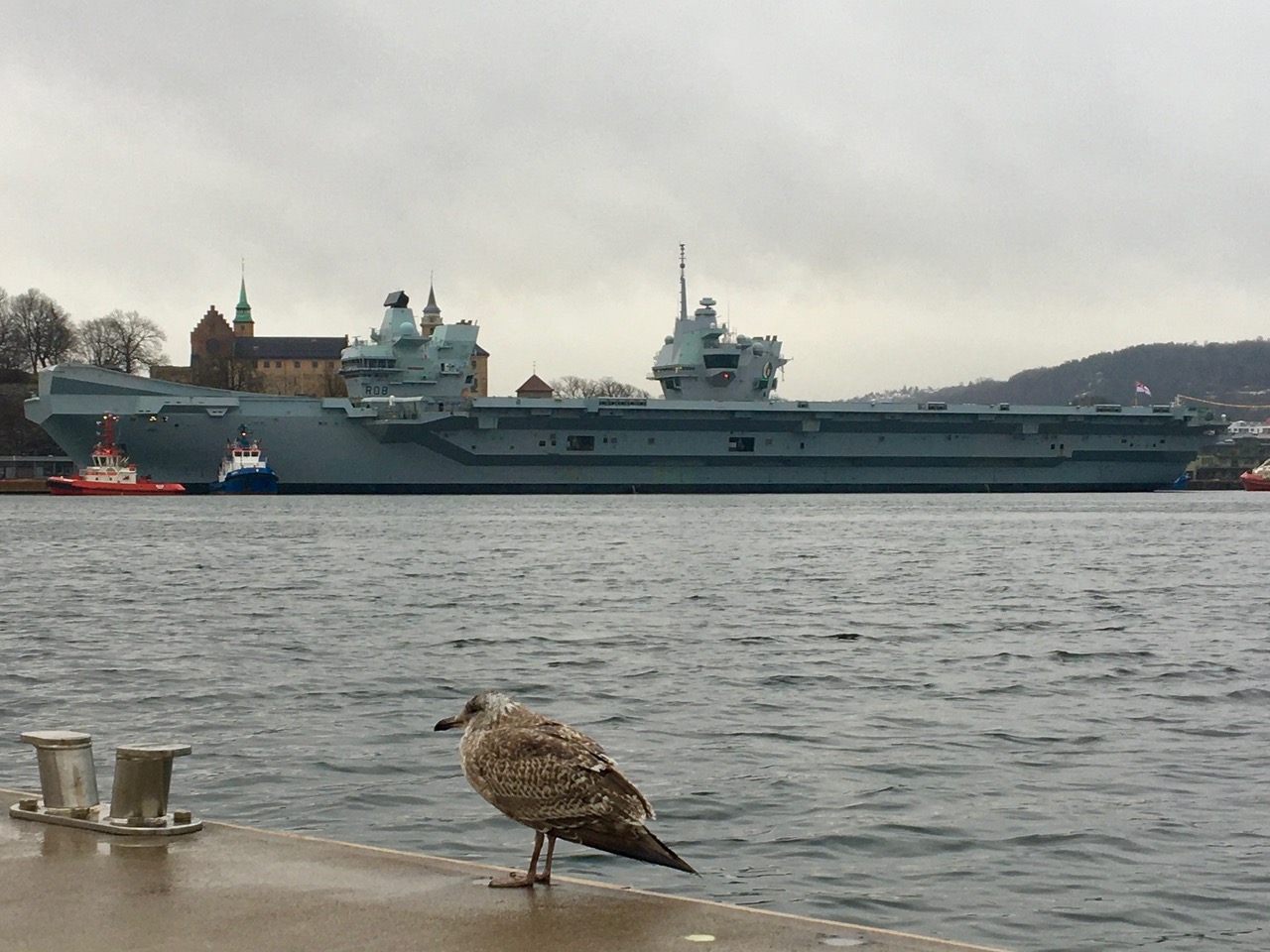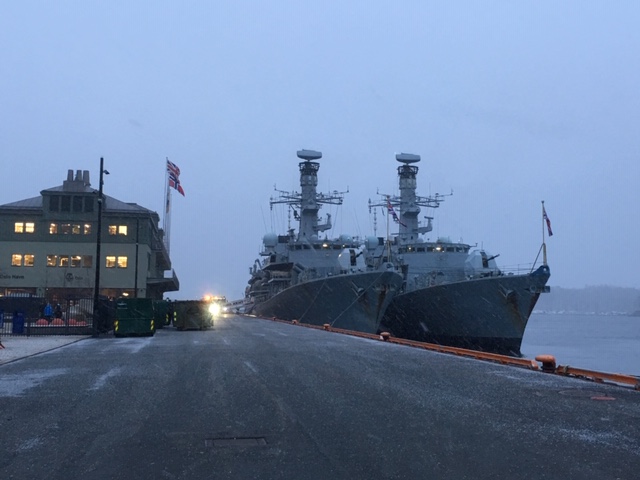Some of the most important vessels in the British Navy attracted lots of attention when they berthed for a three-day show of strength in Oslo’s harbour this week. As they sailed out on Thursday, though, Norway’s own defense forces could be reassured that Norwegians think they’re doing a good job of protecting them along with NATO allies.

The flagship of the British fleet and several escort vessels sailed up the Oslo Fjord after nearly two weeks on patrol in the North Sea. Their visit symbolized how defense has become a priority since Russia invaded Ukraine in April, and since Norway’s offshore oil and gas installations suddenly became potential targets.
Norway’s own defense forces have also become much more active in recent months, as have those of other NATO allies. The Norwegian government has repeatedly announced increased preparedness and put all branches of the service on high alert.

Complaints continue, though, that defense spending hasn’t been adequate and military forces have what newspaper Aftenposten has described as “serious and critical deficiencies.” Opposition politicians in the Conservative Party claim they now want to boost the Labour-led government’s proposed defense budget by another NOK 1.4 billion, based on an analysis that war and conflict in Europe will continue.
“The Russians are preparing for a long-term conflict,” the Conservatives’ Ine Eriksen Søreide, now leader of the defense and foreign affairs committee in Parliament, told Aftenposten late last week. “And even if the war should miraculously end tomorrow, its consequences will be felt by generations ahead.”
Søreide, a former defense- and foreign minister, said that’s because “we have a neighbour (Russia shares a border with Norway in the far north) that is both more unpredictable and potentially much more dangerous. Confidence in Russia internationally and as a neighbour has been destroyed. That’s the reason that we must be prepared that this (the higher threat situation) is something that will last for a long time.”

Søreide also warned of “lots of use of hybrid warfare” in addition to sabotage, cyber attacks, attempts to influence governments and to divide European- and other western cooperation. “They want to stir fear in us,” Eriksen said, “and we have to protect ourselves against all of it. Right now we’re seeing how Russia is directing gruesome and targeted attacks against civilians (in Ukraine) and civilian infrastructure. I think we will see more brutality and destruction.”
Norwegian Defense Chief Eirik Kristoffersen has also declared that Norwegian preparedness “is by no means good enough.” He’s been allocated big budget increases at a time when the rest of the state budget is tight, but it’s not enough to make up for all the lack of investment since the Cold War ended and most thought Russia was now a friend.

Despite all the concerns, a majority of Norwegians appear to have faith in their own defense forces. In a survey conducted by research firm Norstat for Aftenposten in October, fully 78 percent of those questioned have at least some degree of confidence in the Norwegian army, navy, air force and home guard. Of those questioned, 31 percent said they have “quite a high degree” of confidence that Norwegian defense would “protect the public” and be able to handle an “attack from a foreign power.” Another 15 percent said they had “very high confidence” and 32 percent have “some confidence.” Only 15 percent had “little confidence” and 6 percent had none.
That means public confidence in Norwegian defense “is reasonably high,” said Johannes Berge, an election researcher at Norway’s institute for social research (ISF). Nor does he think it’s unusual that only 15 percent have “very high confidence” in their defense: “That’s a sign that folks don’t rely blindly that our defense forces can solve every situation, and in a democratic country, we want people to think for themselves and be critical.”
Norwegians also seemed proud last week of their former prime minister, Jens Stoltenberg, who’s now in his eighth year as secretary general of NATO. Not only is Stoltenberg widely credited with keeping the defense alliance together and rallying support for Ukraine, he also had to quickly calm fears when a missle landed over the border from Ukraine in Poland and killed two Polish men. The war has come closer to many NATO allies in recent months, but it was the first time it claimed victims.

“I was concerned,” Stoltenberg told Aftenposten in what was widely viewed as an understatement. A Russian attack on a NATO ally like Poland can trigger the defense alliance’s “all for one and one for all” policy, and set off full-scale war.
Instead, Stoltenberg could confirm less than a day later that the missile wasn’t from Russia. The confirmation was a result of very busy airspace over Eastern Europe since the February invasion that includes AWACS (Airborne warning and control system) flights that can follow a missile’s range. In this case, they determined the missile was not Russian, even though Ukraine insisted it was.
Risks remain
Both Stoltenberg and US President Joe Biden declared that Russia had not attacked Poland and thereby helped ward off World War III, suggest defense experts including Paal Sigurd Hilde of the Norwegian defense college (Forsvarets høgskole), “if you want to take it that far. They could determine relatively quickly that this was probably an accident.”
Hilde warned, though, that the incident also shows that with a war like the one going on in Ukraine, “the risk is there that something can go wrong and in the worst case develop into a war between NATO and Russia.” That’s what still has many Norwegians and others on edge, not least after Russia harshly criticized Norway’s decision to sharpen preparedness and defense.
The Russian government has claimed that Norway is raising tensions by boosting defense, especially in the Arctic, and causing “the final destruction of Russian-Norwegian relations.” Government spokeswoman Maria Zakharova also complained that “foreign bases” have been established in Norway “on a permanent basis” and that “Oslo is now among the most active supporters of NATO’s involvement in the Arctic.”
Newspaper Dagsavisen reported recently on how Norwegian researchers think Russia is “sharpening its rhetoric” after Zakharova also claimed Norway was deliberately following “a destructive course towards an increase in tensions” and that all “unfriendly” actions would be met with a “timely and adequate response.” There was no such mention of Russia’s actions against Ukraine.
NewsinEnglish.no/Nina Berglund

